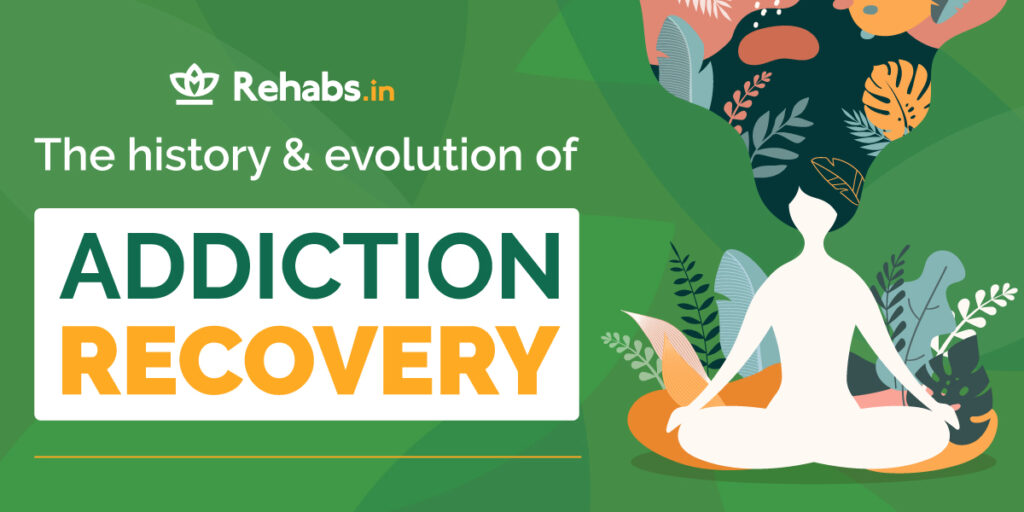The history and evolution of addiction recovery

Humans have used addictive psychoactive substances since ancient times. They were used by priests in religious ceremonies to reach states of dissociative trance and by healers for medicinal purposes with opium being the drug of choice. The general population also partook in addictive substances like alcohol, nicotine and caffeine which were more socially accepted. The problems of addiction started arising when our forefathers found ways to refine more potent compounds and invented faster routes of administration. For e.g. Opium was traditionally used as a medication for pain relief and anaesthesia, however, its derivatives morphine and heroin, which are highly potent became the real cause of addiction.
The history of addiction dates back to ancient times. The Bible mentions Noah’s drinking habits and intoxication and ancient medical records across Asia, whether Chinese, Hindu or Islamic mention the use and abuse of Opium. The earliest records of addiction discourse date back to the times of Aristotle (385 BC – 323 BC). Aristotle alleged that substance dependence was a defect in a person’s ability to exercise willpower. Over the centuries the treatment of addiction has evolved, from barbaric inhumane practices like teeth-pulling, shock therapy, jail time and even death to now more humane methods of sobriety houses, group therapy, CBT and aversion therapy.
Drug addiction treatment over the decades
Following are the different types of drug addiction treatment invented starting from the 1800s when addiction to psychoactive substances started becoming a cause of concern. Some treatments were discarded and some overlap with other forms of addiction treatment. This is not an exact chronological order but a rough estimation of addiction recovery and drug addiction treatment methods over the decades.
1800s: Alcohol and opium addiction was most prevalent during this time and addiction treatment involved the use of morphine or cocaine.
1879: The Keeley Cure, or the “Gold Cure,” was introduced and it involved injecting solutions comprising gold, strychnine, and alcohol into those fighting alcohol, narcotic, or nicotine addictions. There were over 200 Keeley Institutes by the end of the 19th century and although the use of injections may have made no difference, the counselling offered there may have laid the foundation for group therapy and community support organizations.
1800-1900s: The use of hot or cold water to “shock” the system with hydrotherapy could have been used to treat addiction to alcohol. This method was also used to treat mental illness. This could have also raised the stigma around addiction.
1900s: A method that likely had a high death rate was putting individuals into a state of coma by injecting them with high doses of insulin or bromide with the belief that when they woke up, they would be cured of their addiction.
1909: The toxic nightshade plant belladonna was being used as a cure for drug addiction and alcoholism and while it may induce severe hallucinations.
1899-1903: Antibodies to alcohol, derived from horse’s blood, were introduced via cuts in the skin of individuals addicted to alcohol. Equisine was introduced and soon discontinued as a potential vaccine for alcoholism.
1935: Codeine or subcutaneous morphine injections were given to manage medical withdrawals of addiction to alcohol.
1935: Aversion therapy for alcoholism involved introducing unpleasant stimuli every time alcohol was presented, possibly by inducing nausea.
1940-1950: Addiction was thought to be caused by a dysfunction in the endocrine system, and people with addiction issues were injected with adrenocorticotropic extracts from the adrenal gland.
1948-1952: Addiction and addictive behaviours were linked to the prefrontal cortex. Frontal lobotomies, or the surgical removal of the frontal lobe of the brain, were performed on individuals addicted to drugs or alcohol. However, this also caused passive behaviour as well loss of emotional response to life.
Mid-1950s: Electroshock therapy (ECT), where individuals with addiction issues were repetitively shocked with wires attached to their heads and bodies.
1950-1960: LSD, the hallucinogenic drug, was used in the treatment of alcoholism.
Current day: Legitimate and science back treatments like Group therapy, 12 step treatment, Cognitive Behavioural Therapy (CBT), Deaddiction centres, etc., are now the most popular methods of drug addiction treatment. However, even today if you go on the internet, you may find “strange cures” for addiction, all of which certainly have no scientific backing and may cause more harm to a person suffering from addiction.
Modern methods of drug addiction treatment
Thankfully, the scientific and medical community views addiction as a disease and not something that arises out of moral failings. The disease theory of addiction suggests that brain chemistry is altered through regular substance abuse, which leads to behavioural and compulsive drug-abusing behaviours that can be treated by pharmacological and therapeutic methods. Following are some of the most common drug addiction treatments of modern times. They may be used by themselves or in combination with other treatments, depending on the severity of the addiction.
Detoxification – This process is done under strict medical supervision as substance withdrawal can create unpleasant and even life-threatening physical symptoms. Detoxification allows you to remove the addictive substance from your body. As detoxification does not treat the underlying behavioural causes of the addiction, it is usually used in combination with other therapies.
Cognitive Behavioral Therapy – CBT not only allows you to distinguish your unhealthy behavioural patterns, but it can also assist you in identifying your triggers and developing coping skills that are suitable to you. Due to its individual nature of treatment CBT can be used for all forms of addiction, be it drug or alcohol or even food addiction.
Rational Emotive Behavior Therapy – Rational Emotive Behavior Therapy (REBT) can assist you to identify your negative thoughts and empower you with methods to fight the feelings of self-defeat. The purpose of REBT is to help you understand that the power of rational thinking is within you and is not connected to external situations or stressors.
Contingency Management – Contingency Management (CM) is often used to treat an extensive array of addictions including alcohol, narcotics, and tobacco. Contingency management therapy reinforces your positive behaviour (i.e., abstaining from drugs or alcohol) by giving you rewards, which could be tangible or intangible, for. e.g., sobriety chips given in AA/NA groups.
12-Step Facilitation – Twelve-step facilitation therapy (“12-step programs”) is used to various kinds of addiction, be it drugs, alcohol, sex, etc. It is a type of group therapy that includes the belief that addiction can have several negative consequences on one’s social, emotional, spiritual and physical state. Therapy starts with acceptance of a problem, then moves on to submission to a higher power and the need for help, followed by regular group meetings. Alcoholics Anonymous were the first to introduce the 12 steps therapy and it is now used by many addiction centres around the world.
Drug addiction treatment with medication – Deriving from the aversion therapies of the past, certain medications are used to lessen cravings, improve mood, and reduce addictive behaviours. For example, the FDA recently approved lofexidine to help combat cravings and withdrawal symptoms in individuals with opioid addiction. Medications like acamprosate may also help with alcohol addiction problems. It is important to note that these medicines are to be taken under the strict guidance of a medical doctor or a certified psychotherapist.
In the last century and before that, addiction was viewed as a moral failing or a mental illness. This resulted in a huge stigma around addiction. In some places, people with addiction issues were sterilized to stop them from procreating and spreading addiction to the next generation. Individuals with addiction problems may resort to thieving to fund their addictions, and some may withdraw from society causing their near and dear ones to believe that they are mentally ill. However, the right course of action is not punishing them for their crimes but getting them the help they need by either counselling them or admitting them to deaddiction centres.
The Ministry of Health and Family Welfare and the Ministry of Social Justice and Empowerment offer free treatment to their citizens who are suffering from addiction problems. Drug Treatment Clinics (DTC) offer outpatient treatment services and Integrated Rehabilitation Centres for Addicts (IRCAs) take care of inpatient treatments. Currently, there are 27 DTCs and 480 IRCAs across India and these centres are overseen and coordinated by the NDDTC, AIIMS, and are majorly operated by NGOs.
The history of addiction treatment has been a long and painful journey. Today drug addiction treatment is humane and easily accessible. If you or your loved ones are facing problems of addiction then you may seek help here.
Sources:
Marc-Antoine Crocq, MD (2007, Dec) Historical and cultural aspects of man’s relationship with addictive drugs
https://www.ncbi.nlm.nih.gov/pmc/articles/PMC3202501/
Underwood. C., Anderson. C., (2020, Dec) 6 Treatments For Addiction That Are Proven Successful
Department of Social Justice and Empowerment. NashaMukt Bharat: Annual Action Plan (2020-21) for 272 most affected Districts
https://grants-msje.gov.in/display-drugs-action-plan
“Before Prohibition: Images from the Preprohibition Era When Many Psychotropic Substances were Legally Available in America and Europe.” Addiction Research Unit. Department of Psychology University of Buffalo.
“Fargo North Dakota: its History and Images.” North Dakota State University (NDSU) Libraries. Accessed November 8, 2015.
https://library.ndsu.edu/fargo-history/?q=content/keeley-institute
Quest for a Cure: Care and Treatment in Missouri’s First State Mental Hospital. Office of the Secretary of State, Missouri.
https://www.sos.mo.gov/archives/exhibits/quest/treatment/1930-1950
Chiang, H. (April 2009). “An Early Hope of Psychopharmacology.” Princeton University.
https://sites.google.com/a/medicinae.org/historia-medicinae/e06
Markel, H. M.D. (April 2010). “An Alcoholic’s Savior: Was it God, Belladonna, or Both?” The New York Times.
Acker, C. PhD., Kurtz, E. PhD., White, W. MA. (2001). “The Combined Addiction Disease Chronologies.” William White Papers.
http://www.williamwhitepapers.com/pr/2001Addiction%20as%20Disease%20Chronology.pdf
White, W. (1998). “Significant Events in the History of Addiction Treatment and Recovery in America.” Chestnut Health Systems.
http://www.williamwhitepapers.com/pr/AddictionTreatment&RecoveryInAmerica.pdf
Greenburg, D. (Sept. 2012). “10 Mind-Boggling Psychiatric Treatments.” Mental Floss Magazine. Accessed November 9, 2015.
https://www.mentalfloss.com/article/31489/10-mind-boggling-psychiatric-treatments
(2005) “Medication-Assisted Treatment for Opioid Addiction in Opioid Treatment Programs. Treatment Improvement Protocol (TIP). Series, No. 43.” Substance Abuse and Mental Health Services Administration (SAMHSA).
Lemere, F. MD. (1987). “Aversion Treatment of Alcoholism: Some Reminiscences.” British Journal of Addiction.
https://psych.hanover.edu/classes/Learning/articles/Lemere(1987).pdf
Schachter, M. MD. FACAM. (2014). “Causes of Adrenal Insufficiency.” Schachter Center for Complimentary Medicine.
Hamby, W.B. M.D., Mason, T.H. M.D. (April 1948). “Relief of Morphine Addiction by Prefrontal Lobotomy.” The Journal of the American Medical Association (JAMA).
https://jamanetwork.com/journals/jama/article-abstract/299493
(2003). “Quest for a Cure: Care and Treatment in Missouri’s First State Mental Hospital.” Office of the Secretary of State, Missouri.
https://www.sos.mo.gov/archives/exhibits/quest/treatment/1930-1950
White, W.L. (2002). “Trick or Treat? A Century of American Responses to Heroin Addiction.” Auburn House. Accessed November 9, 2015.
http://www.williamwhitepapers.com/pr/2002HistoryofHeroinAddictionTreatment.pdf
(Spring 2007). “The Science of Addiction: Drugs, Brains, and Behavior.” National Institutes of Health. NIH Medline Plus. Accessed November 9, 2015.
https://magazine.medlineplus.gov/pdf/spring2007.pdf












